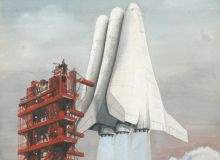

Discover B2B Marketing That Performs
Combine business intelligence and editorial excellence to reach engaged professionals across 36 leading media platforms.
To celebrate the opening of a new heritage centre at the company’s military aircraft factory in Warton, Lancashire, the company has released a series of designs whose retro-futuristic looks wouldn’t look out of place on Thunderbirds.
Produced by BAE Systems’ predecessor companies, including English Electric, Hawker Siddeley and the British Aircraft Corporation, some of the original sketches now roar into life using modern animation techniques.
Howard Mason, heritage manager at BAE Systems said: "Although 50 years have passed since these extraordinary designs were first put to paper, we can see how some of the technologies and ideas were developed over time and put to use now in aircraft like the F35 Joint Strike Fighter.

US Tariffs are shifting - will you react or anticipate?
Don’t let policy changes catch you off guard. Stay proactive with real-time data and expert analysis.
By GlobalDataAircraft and vehicle engineering involves producing and analysing literally thousands of iterations and while today the process is speeded up through the use of computer modelling, it’s fascinating to look through our archives and see what engineers were working on at that time."
MUSTARD hypersonic aircraft
Proof that elaborate acronyms aren’t a modern development, the British Aircraft Corporation (BAC) designed the Multi-Unit Space Transport And Recovery Device (MUSTARD) in 1964.
Capable of reaching air speeds five times the speed of sound, MUSTARD was designed as a reusable space plane, the next evolution of the Apollo programme that put man on the moon, but for a fraction of the development cost.
The aircraft was formed of three separate crewed, delta-winged sections, each of which displayed shared ancestry with the Space Shuttle and BAE Systems’ current project, the X-37.
Launched slotted together as a single unit, the two outer units would act as a booster to deliver the third into space, and all were designed to fly back to Earth like regular aircraft once their mission was complete.
The piggy-back fighter jet platform
Jet fighters: fabulous when you have a long runway or aircraft carrier to hand, but not so handy when you need to take off or land from a short runway or in a jungle clearing.
For those times when helicopters just aren’t up to the job, the Fighter Jet Take-Off Platform was a concept design that would take off from the most constrictive of landing strips carrying a winged aircraft on its back that could take off once in the clear.
The innovation was born from a collaboration between Shorts, which created the hovering P17D platform, and English Electric, which developed the lightweight piggy-backing P17A tactical strike and reconnaissance jet.
No quiet neighbour, the P17D would have used 56 jet engines to take off with its aircraft payload, and between missions could have been used to deliver freight to otherwise inaccessible locations.
Once again, tight budgets and complexity of operation were to blame for the Fighter Jet Take-Off Platform not making it off the drawing board.
Jumping Jeeps and Intercity Vertical Lifters: BAE’s forgotten designs
To watch animations of other mothballed designs, including the extraordinary Jumping Jeep as well as the mothballed passenger air revolution that could have been the Intercity Vertical-Lift Aircraft, please click on the links below.
Related content
Intercity Vertical-Lift Aircraft
The Intercity Vertical-Lift Aircraft design from the Hawker Siddeley company was an attempt to bring vertical take-off and landing (VTOL) to commercial aircraft.
A number of designs were drawn up during the 1960s, looking very similar to our passenger planes today; however featuring rows of lift fans on either side of the body of the plane.
Jumping Jeep
To celebrate the opening of a new heritage centre the company has released an astounding series of retro-designs – including the extraordinary Jumping Jeep.
Reminiscent of modern VTOL flying car designs, such as Terrafugia’s, the Jumping Jeep was a concept vehicle designed by BAC Warton in the 1960s as a 4×4 transporter capable of leaping over obstacles.







